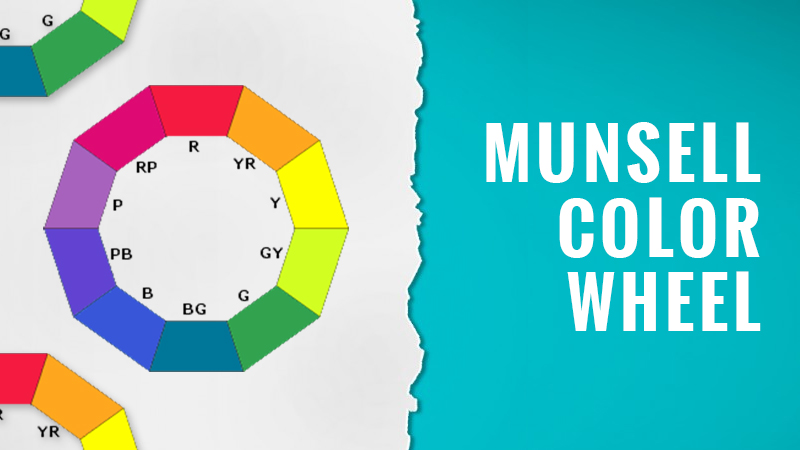How to Use the Munsell Color Wheel?
Are you curious about how to use the Munsell color wheel? Stick around as we will share the answer in this article…
As children, we learned about the color wheel from our very first exposure to formal art education during primary school. During your lessons, your teacher probably showed you a color wheel to illustrate the primary, secondary, and tertiary colors.
It is also used to demonstrate fundamental color relations.
The traditional wheel is definitely one of the most important starting points when it comes to learning about colors. However, as your art education progressed, you may have learned about other aspects of color theory.
If you continue your art education beyond the basics, one thing you are bound to learn is the Munsell color wheel.
Not familiar with this concept? You can learn about it in this article. Just keep reading…
What Is the Munsell Color Wheel?
We will begin with a little background on this wheel. The idea for this concept was first presented by artist and art teacher Albert Munsell back in 1905.
According to him, colors have three properties, namely hue, value, and chroma. He used numbers to provide a clear definition of each color using these attributes.
He designed a system of numbering the colors and arranging them on a scale to provide a visualization of the three attributes. The result is a circular illustration that closely resembles the traditional color wheel.
In Munsell’s approach, hue is described as the native color.
This refers to what we traditionally know as the primary, secondary, and tertiary colors, namely red (R), red-purple (RP), purple (P), purple-blue (PB), blued (B), blue-green (BG), green (G), green-yellow (GY), yellow (Y), and orange, referred to as yellow-red (YR).
When you look at the Munsell color wheel you will notice that there are colors between the hues mentioned above. These different colors are arranged according to their value and chroma.
According to Munsell, value is the lightness or darkness of the color, which can range from 0 (darkest or black) to 10 (lightest or white).
On the other hand, chroma refers to intensity or saturation, ranging from 0 (dullest and neutral gray) to as high as the saturation can go.
There is no set number because new colors are discovered over time, indicating a need for a spot to place the more intense colors which are yet to be discovered.
One of the most effective ways to visualize this color wheel is through a three-dimensional representation of it, also called the Munsell color tree.
You might be wondering: How does this differ from the traditional color wheel? Read on to learn the answer.
What Makes the Munsell Color Wheel Unique?
In a way, Munsell’s concept has the same goal as the traditional color wheel. It seeks to provide a depiction of colors and their relationships with one another.
However, experts note that Munsell’s circle uses a much more logical approach and a much easier-to-understand illustration. This is thanks to the nomenclature and numerical scale he conceptualized.
If you are still confused as to how you can use this wheel, then you should definitely continue reading…
How to Use the Munsell Color Wheel
Above, you learned the basic concepts used in the Munsell color wheel. You also learned how hues are named, as well as how value and chroma are measured. So, when you look at a wheel that follows Munsell’s approach, you will naturally find numbers and letters mixed in with the colors.
Usually, colors in this circle are referred to in this way: 7.5B 5/12. This identifies the hue 7.5 blue, with a value of 5 and a chroma of 12.
You can easily identify the hue, value, and chroma by looking at its location.
For example, a blue that falls between 10B and 5B is a 7.5B. This is the hue. Now, look further and you will see that the segments for each color have a ‘gradient’ effect, going from a brighter blue to duller versions and eventually to a neutral gray.
What you are seeing is the chroma. In the given example, the chroma is 12, which is relatively saturated.
You might be wondering how you can see the value of color using Munsell’s approach. The best way to do this is through a chart or a color tree.
Think of a 3D version of the wheel, with chroma coming from the trunk (center) going outward, starting from neutral gray to more saturated versions of the hues.
Now, think of the trunk as the indicator for value. The lower you go, the darker the value is, and vice versa. In the given example, the value is 5, which means that the lightness/darkness is balanced as it is in the middle.
Conclusion
Describing color does not need to be abstract. Instead of saying “blue like the sea,” you can use Munsell’s way of identifying colors to show the exact hue, value, and chroma of the color thus describing the exact color you are looking for.
I hope you enjoyed our explanation of how you can use the Munsell color wheel.
Read Latest Posts

Hi, I'm Anthony Tran! Welcome to my site. I live in Arizona and am obsessed with all things related to building an Online Business and working from home. Learn about my journey here.
Follow Online



